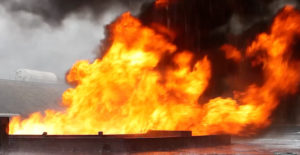When a flammable vapour ignites, the fire may progress in a number of different ways and frequently in more ways than one at the same time including:
- jet fire,
- flash fire,
- pool fire.
Jet fire:

A jet fire occurs when a flammable liquid or gas is ignited after its release from a pressurized, punctured vessel or pipe. This results in a jet of flame being released with some considerable momentum from one or more points in the process.
Jets result in a high-temperature burning material being sprayed on to the installation and, as a result, can cause
considerable damage very quickly. The jet may extend for a considerable distance and impact on surrounding structuresand vessels, and induce additional fires or cause structural collapse.
Flash fire:
It’s a rapidly moving flame front which can be a combustion explosion. Flash fire has a heat flux of approximately fire 80 kW/m2 for relatively short periods of time, typically less than 3 seconds.
In a flash fire, the flame spreads at subsonic velocity, so the overpressure damage is usually negligible and the bulk of the damage comes from the thermal radiation and secondary fires.
Pool fire:
 A pool fire is a turbulent diffusion fire burning above a horizontal pool of vaporising hydrocarbon fuel where the fuel has zero or low initial momentum.
A pool fire is a turbulent diffusion fire burning above a horizontal pool of vaporising hydrocarbon fuel where the fuel has zero or low initial momentum.
Pool fires result from the spillage of fuel under low pressure, which are ignited after release and the pool has developed. They may also be the result of a tank or pipe failure that has not ignited as a jet fire but has travelled out of the container to form a pool, before being ignited. It is not the liquid itself that is the pool, but the layer of vapour above the liquid and hence, when ignited, forms a pool fire.
Fires in the open will be well ventilated (fuel-controlled), but fires within enclosures may become under-ventilated (ventilation-controlled).
Pool fires may be static (e.g. where the pool is contained) or ‘running’ fires.
A pool fire may also be involved with the ignition of vapour at the top of a storage tank, a so-called ‘rim fire’, which results from failure of the rim seal, or spill-over of the tank contents into the roof as a result of overpressure.
When a pool fire is burning, not all the vapour may be consumed and some may blow away and form a vapour cloud
that may ignite and explode.
As a result of release of flammable material there is also hazard of explosion.
Explosions characteristics will be revealed in the next article which will be issued very soon!

